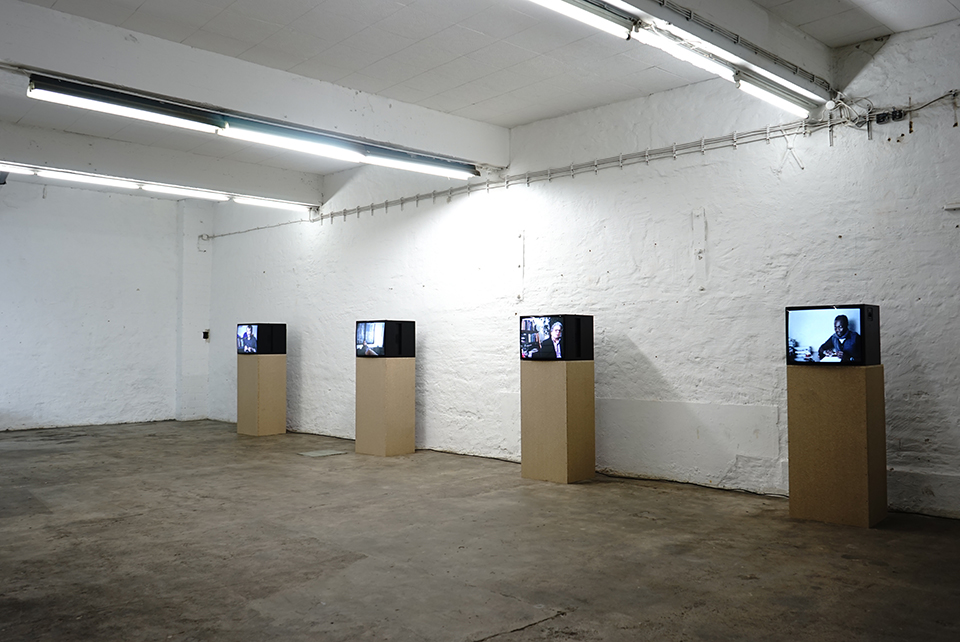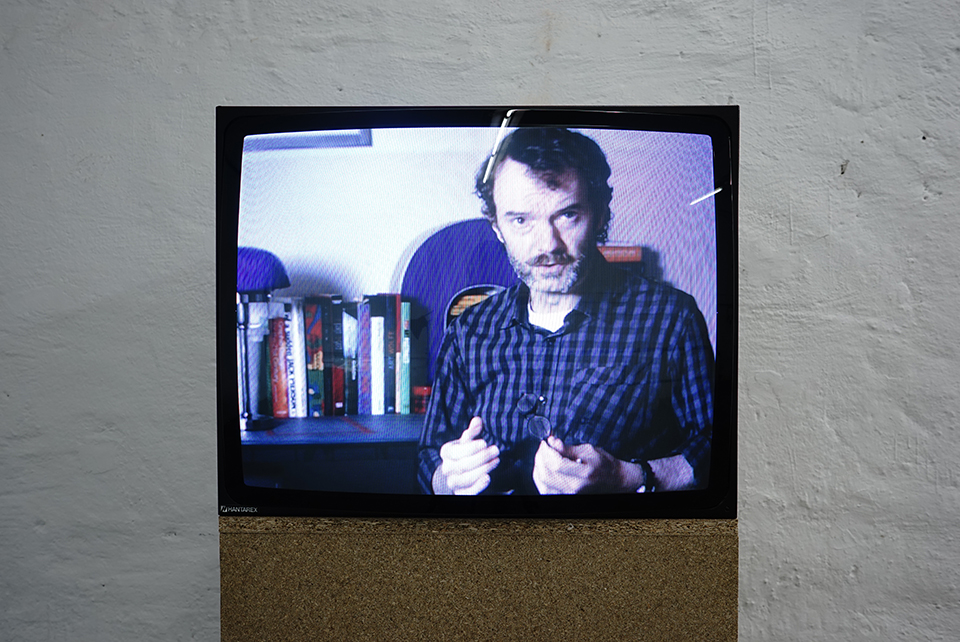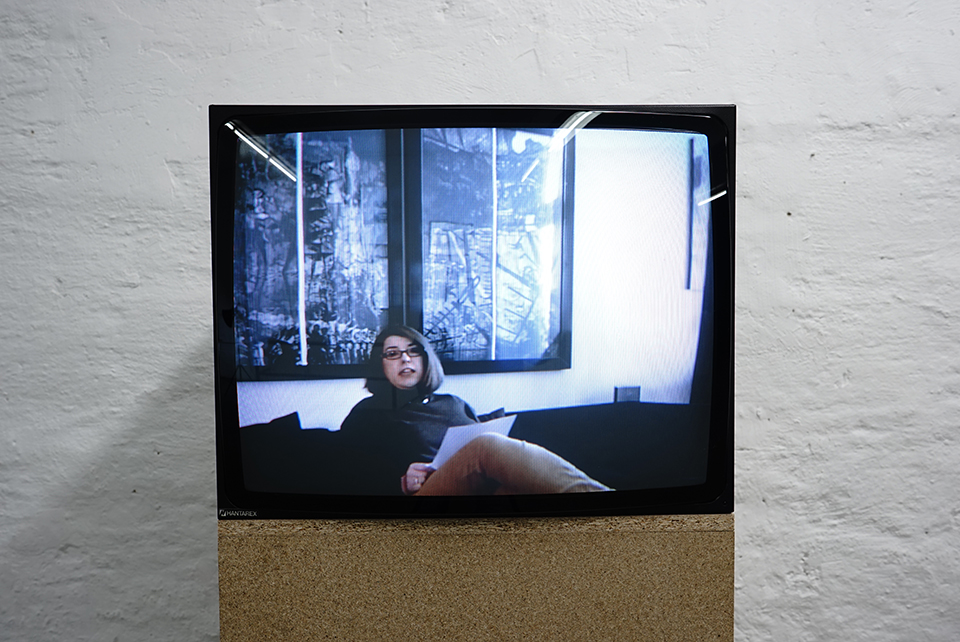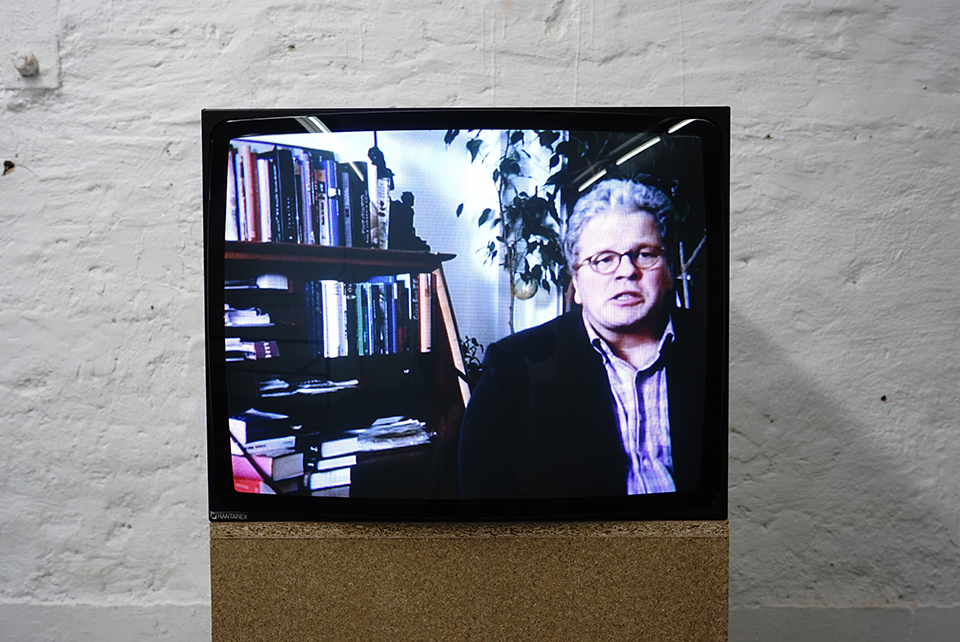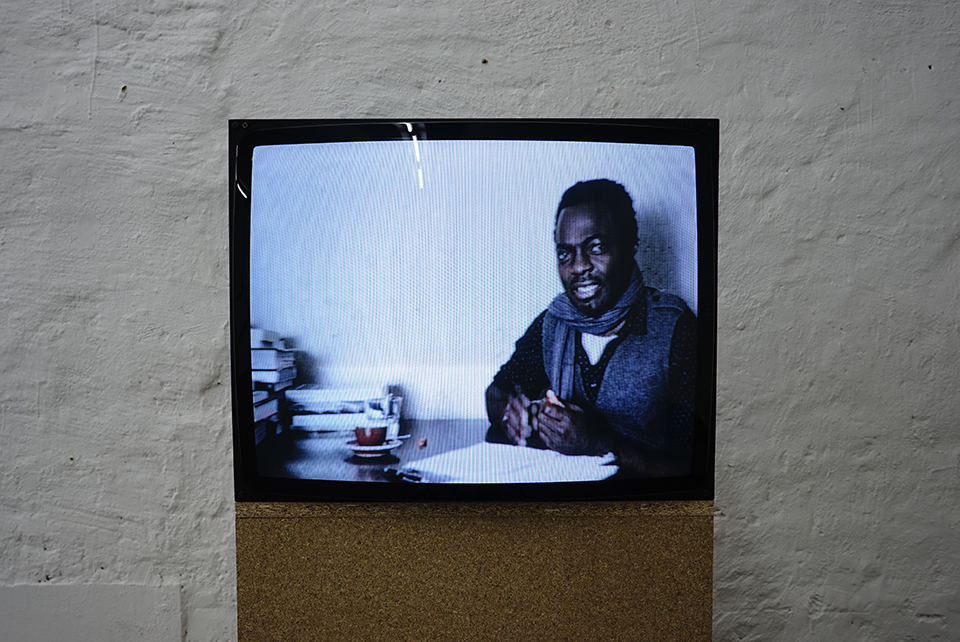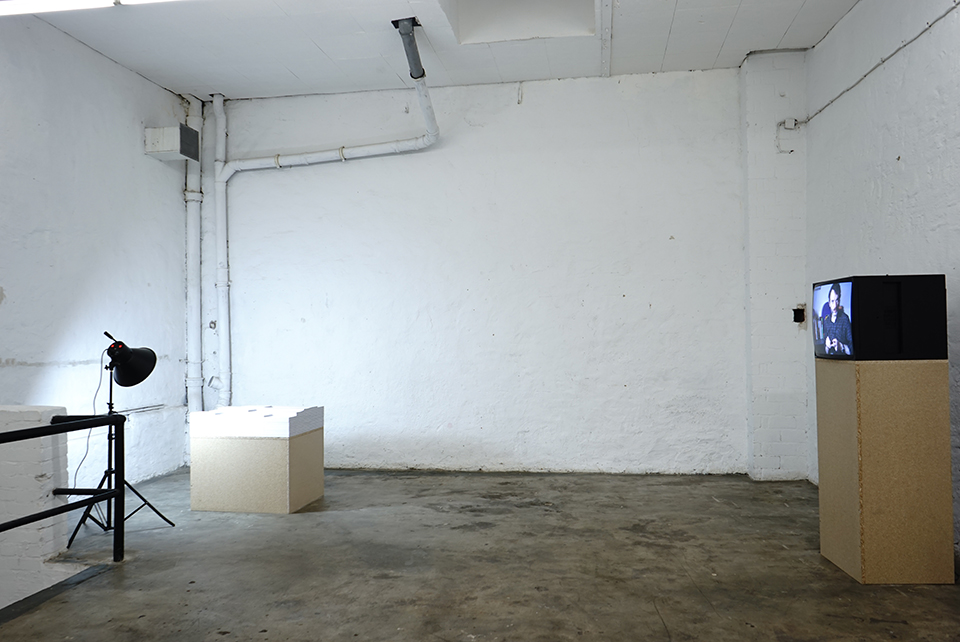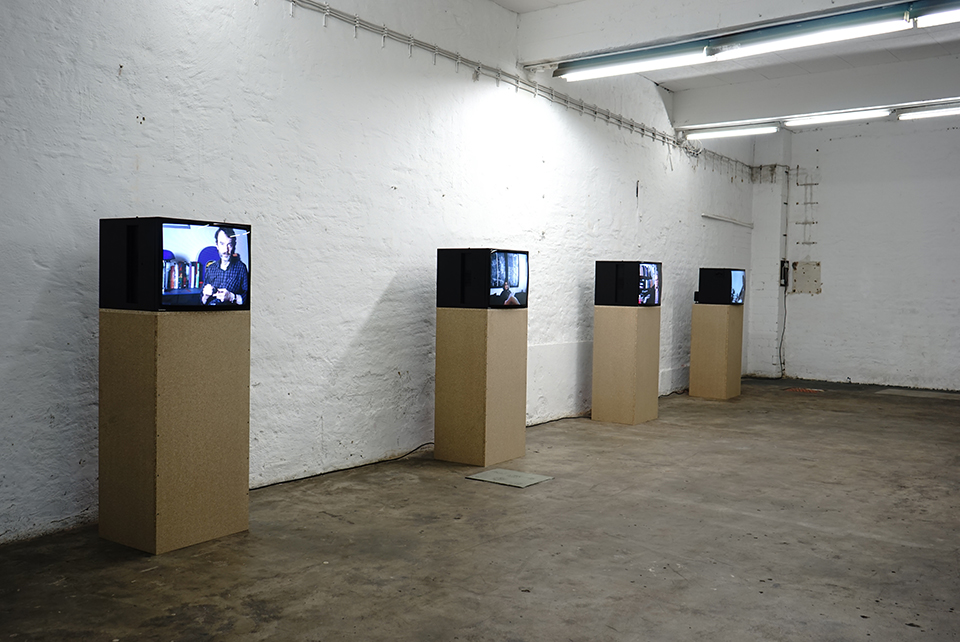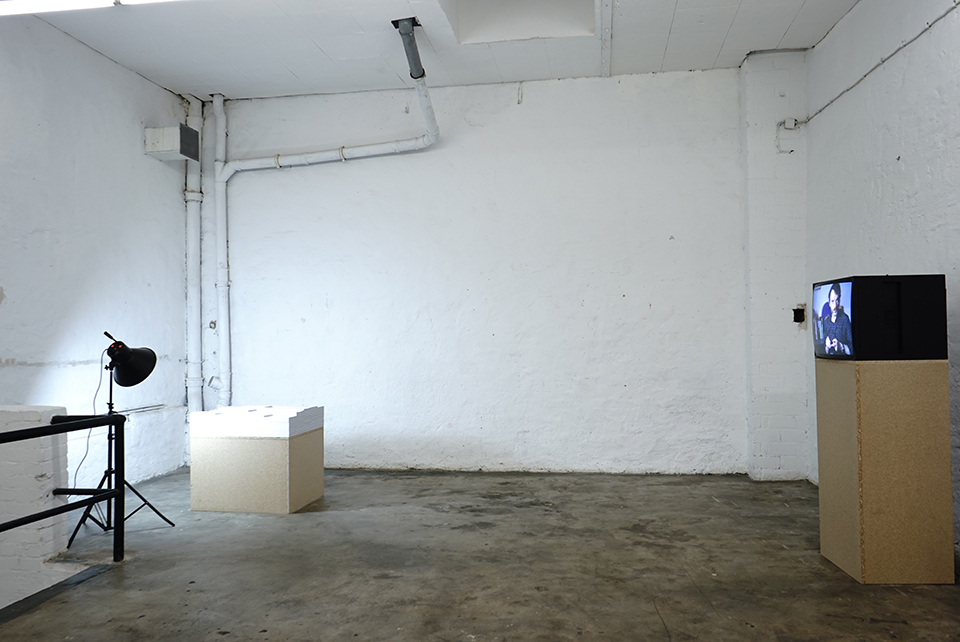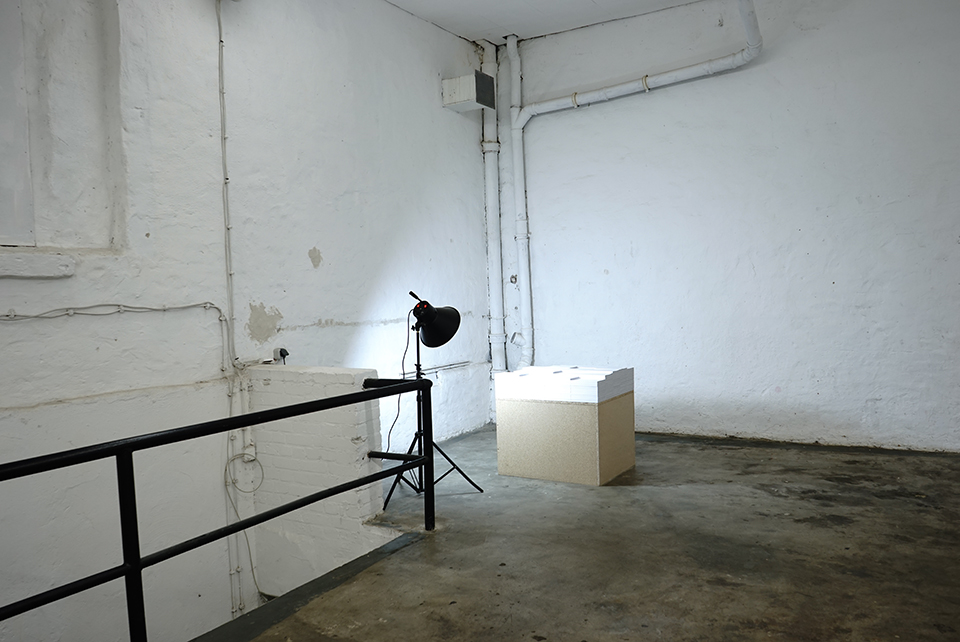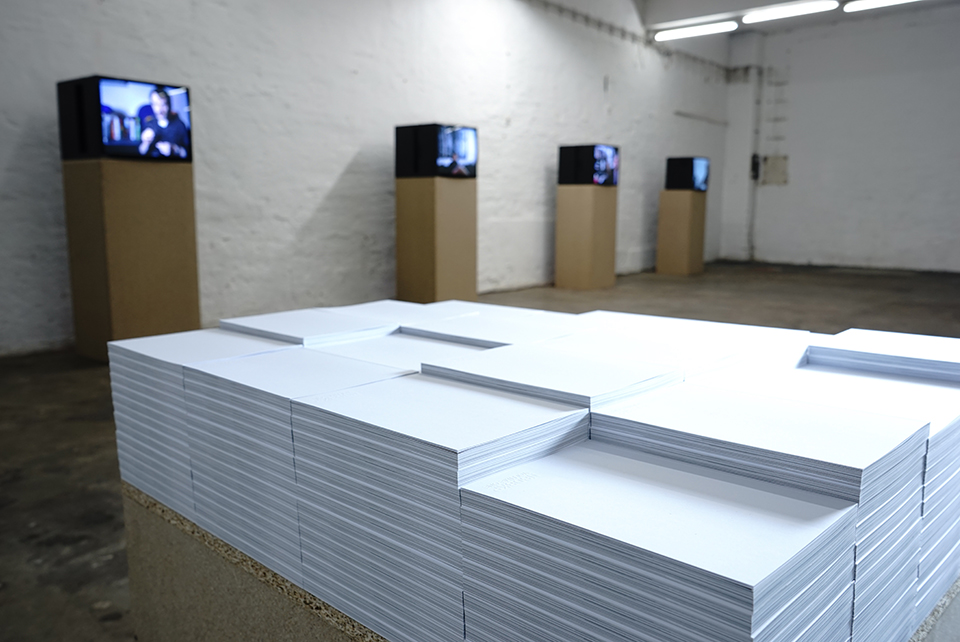In Theory
Four videos of fictional theoreticians performing scripted harsh critiques of our artistic practice, each emulating a specific theory genre.
2014
four-channel video on monitor
06:38 min. / 06:41 min. / 06:49 min. / 08:09 min.
installation at the book launch of VOLUME ONE, SFAR, Düsseldorf
Script I: Dan
I will proceed to focus on a disclosure of pseudo-normativity in the work of Barbara Prokop and Niels Betori Diehl, which reconnects to a first cluster of incoherences: that of an extremely dichotomous interrelation between openness and closedness, between a delusion of discoursivity and dialogicity on the one hand, and an obscurantist project of re-mystification of the art-construct on the other hand—both of which are made to coexist within an artistic practice that is so adverse to the debate around the participatory and emancipatory potentiality of discourse-based art and, at the same time, constructs a suggestion of participation and inclusion, though rather in the shape of a secret pact with a limited, enlightened phantasmatic audience or—as Sue-Ann Caulfield would frame it—as the fantasy of a “private discoursivity”. I would define this liminality and transitivity as a feature of a deeply sectarian and self-minoratising self-conception, inherently dependent on a universalising notion of independence from a generic art crowd perceived as a multitude of vulgar and unworthy subjects. The trope of the return to the grand narratives as an ethical necessity resonates within Prokop’s and Betori Diehl’s more polemic pages, in which the matrix of their critique is expanded to the political field, with an emergence of pseudo-reactionary and axiomatic dissociations from the topoi of relativism and fundamentalism, reversed, in a sort of re-legitimisation of authoritarian structures within an already problematic set of definitional binarisms unfolded through their simultaneous rejection and renegotiation of plurality as a mass of inert, available elements, which have no voice and only a history. Again, here, even in their notion of “history” as purely a product of systematic and unquestionable articulations of power in the overdetermined spectrum of hegemonial Western force fields, Prokop’s and Betori Diehl’s systematisation of the term alludes to an almost liturgical reading of art history, which owes much to a right-Hegelian and Kantian vision of purity, and, especially in regard to Kant, to an idealistic separation of art from the sphere of all social interactions. As we know, these attempts at recreating a mystique of artistic experience are inseparably related to a neoliberal superstructure, which is especially effective in absorbing and reverting a notion of difference into the pseudo-normative construct already reformulated in a libertarian sense, and closely interlinked with another complex of signifying tools, which I would define as that of cognitive hyper-stimulation and which corresponds to the generation of a trance-like state described by Prokop in relation to Betori Diehl’s video installations, where meaning is obliterated by pure effect and the possibility of a political agency of art is completely rejected. As Thoraux has made very clear in his recently re-issued Queering the Standpoint: The construction of Identitarian De-Identification, to which I am proud to have contributed a new introduction, both the negation of political agency and the normativisation of difference I mentioned before are deeply rooted in the ideology of neoliberalism as is the suggestion of a meta-plurality, which is consumed by the apparatus of oppressive narratives of globalised meaning production and re-signified as an infinite plurality of differences, in which all is externalised and—and here we experience the brilliance of Thoraux’s epistemological twist in the matter, which he delivers with incredibly lush language—quote: “in a policed openness reverted, a rivulet still imbibing the malleable memory of pre-capitalist intricacy long lost, a presque-closeness, which is not merely contra the open, but in fact the expression of a closeted self, as in the merciless worldliness of neoliberalism all must be closeted but the commodification of the policed openness”—end quote. In Prokop’s and Betori Diehl’s work this modernist neoliberal narrative is implicit and tragically concealed, more tragically so as this concealment is not deliberate, but unconsciously reproduced, in a condition of—to use Thoraux’s own words again—“permanent closeted closedness”.
Script II: Dagmar
In Karsten Tauwald’s and Christian Volckert’s Binäre Geschlechterkonstrukte nach der Anthropologischen Wende, which owes much to Foucault’s interdisciplinary approach, a fascinating utopian system of thought is established, in which the construction of gender is made dependent on its formulation within a framework that sees the renunciation of polarities prevail. The philosopher Tauwald and the sociologist and anthropologist Volckert manage to dissolve the dichotomy between male and female and to give shape to a freed self, a fluctuating identity, nomadic in its non-connectivity, which at the same time is freed from the burden of productivity. This poetic, emancipatory vision aspires not only to resolve a duality, but also to deliver a response to the exploitative nature of capitalism. When asked to speak about the work of artists Barbara K. Prokop and Niels Betori Diehl, I was inevitably reminded of Tauwald’s and Volckert’s illuminating treatise, and about how much artists could profit from it. Unfortunately, although tackling similar subjects, in the artists’ work no satisfactory response is offered to the many pressing issues they address: Niels Betori Diehl’s representations of the male body, for example, do not deliver an outside to exploitation. The body is represented in motion, because this body is a working body. The body works for the artist, which produces the work. The work is then made to work for the artist and the circle closes. In 1924, Gregor von Schroff described the resting body as the lascivious body of classical antiquity—dormant, inactive or resting. Within this system, the standing body is, for example, categorised as inactive and finds its supreme expression in the kouros or the Doryphoros. It is the model, which simply is. There is no functionalising momentum within it. Von Schroff distinguishes between the Hellenistic and the pre-Hellenistic dormant, inactive or resting figure, establishing six categories of what he defines the immovable paradigm of the motionless. Almost fifty years later, Schlengen developed this paradigm further, taking one important step, with which he inserts it into the sphere of the political: von Schroff’s immovable paradigm of the motionless is now equated with the citizen in an idealised democracy. The dynamism in Betori Diehl’s video work stands in polar opposition to this paradigm, it transcends the working body insofar as here the body is not just in action, but the action is directed. This body is not just “working”, it is “working for” another entity: it is the crystallisation of exploitative relations in capitalism. As a Lacanian feminist art historian, in my work I mainly concentrate on the body, both in the register of the apparatus as in terms of body relations and their function as a meaning bearer in the psychosocial sphere. In this respect, I was interested in focusing on the gaze Betori Diehl subjects women to in his work, in particular in his video piece Poetic License: we see a black woman laughing and than, subsequently, in tears. The monitor is positioned on the floor, as if inviting one to sit on it. The monitor becomes the bench on which to perform an act of female oppression. What is this work telling us? We can ask the same question about the women in Prokop’s works: secretaries, prostitutes, pop stars… Prokop’s women are women performing first and foremost for her exploitative gaze, but they are at the same time taking on or embodying the classical role men have chosen for them. There is no questioning of their position and no outside is offered to them by the female artist that seems oblivious of an art history based on the systematic exclusion of women. In their collaborative work, Prokop and Betori Diehl extend this instrumental appropriation of bodies as workforce, justifying their reproduction of the exploitative nature of capitalist production with their functioning as “dispositifs” offering a negative critique of the same conditions they are reproducing. Be it the appropriated bodies in Betori Diehl’s videos, the “participants” to Prokop’s performances or the artists’ identities and works manipulated through their incorporation in larger installation projects, there seems to be no awareness of that what Suzanne Parker described in The Veil and the Motorcycle Helmet as “reproducing oppression through oppressive reproduction”. The mechanics of exploitation are at the same time enacted and acted out, they are reality and representation at the same time.
Script III: Hans
The way I look at all this is through the eyes of someone who has gone from believing that things could be changed, that a different approach to art was possible and, yes, that art could be part of this change, to a partial but substantial disillusion. In the past, I have often felt frustrated about the path that was taken by so many in the arts, to the point that I had almost resigned myself to it. However, it was only then that I started to develop a deep curiosity for that what a younger generation was trying to make out of the current situation. A generation of angry—and hungry—artists that are still not giving up and are fighting. They are connected through the new technologies and the social media and they are well-organised. They have taken over the streets and adopted the strategies of political action. In all parts of the world they are putting their work to the service of their communities. As a university professor, I have the privilege of coming into contact with these young politically driven women and men and I support them in the best way I can. I would even say that without the work of the many artist collectives I came in contact with and with whom I collaborated over the years, my analysis of Saint-Simon and his influence on Heine and Marx wouldn’t have been so entrenched in our times and would have surely lacked the many encouraging examples of resistance through art who build on that legacy, which I tried to render in their processuality. So, against this backdrop, when I look at this work and at what artists Niels Betori Diehl and Barbara K. Prokop have to say about it, it just saddens me. It saddens me because I see in it the old mistakes wrapped in new, promising clothing. I see in it the agency of capitalism unquestioned, and I see in it the attempt at retreating into a bourgeoisie that has become irrelevant and that I, as many others, thought would not attract anyone anymore. This old, very old idea of high art, the insistence on a neutral, institutional presentation, this clinging on that same Conceptual art we already at the time considered boring and self-involved… And the loathing, on the other hand, for any attempt at a reformulation of art in terms of a questioning of its sacrality is simply disconcerting. These are artists that should know better. Betori Diehl’s and Prokop’s work is certainly witty and enjoyable at times, if we ignore the stance behind it, so the artists are not exactly doing themselves a favour when speaking out about their work. It just reveals their inability to think outside of the neoliberal box, although they are no “market artists”, although they strive to be critical of the art world. It could even seem comical—if it were not so tragic—how detached from the same reality they believe they are reflecting upon they are, how they persist in targeting the wrong enemies and attack those who they should solidarise with. But these are not my only feelings: it is indeed alarming when the strategies of institutional critique are misused until the point where they are turned against all the battles that were fought and all the efforts at making art accessible, participatory, democratic, empowering and relevant for those who are not part of an elite of educated and knowledgeable initiates. What we have here is an attempt at sabotaging that what has been built up against all odds: Betori Diehl and Prokop are taking a side that ignores and rejects them, their questioning plays into the hands of those already in power, who certainly don’t need their support to thrive and are not interested in participating in any discourse. And this is what neoliberalism does, it generates willing subjects who help to further cement the current status quo, while leaving them the thrill of their little, tame revolt.
Script IV: Sylvester
There is an anger pervading the folds of this introversive dialogue, a helplessness, a cry for help—almost—a desire of being heard and at the same time this turning away, this hardening of one’s heart against that what is unacceptable because it escapes the self-imposed strictness, because it dares to truly be other, to imagine a world that is other. I would frame this… this disgust for the utopia of another world as sort of… what I would call a folding oneself away. In fact, the folding—or ‘doubling’, as Deleuze intended it—of one’s own thought ‘into’ the thought of another… it appears here as a mere exercise in solipsism. From Deleuze and later on through the analyses of Lohmann-Fournier and also in Forster’s rather uncanonical hermeneutics, we have come to look at thought itself as a kind of fold—the folding inside of what Deleuze calls the ‘forces of the outside’. Now, these forces—or rather this forcefulness—of the outside world is what affects these pages or rather it is the affect itself—an intertextual affect affecting the textuality. The outside is experienced as a hostile otherness. The mode of the conversation is rooted in fear: it is the fear of the other other, the unexpected other, the unplanned, the unfathomable other. This is what Klonowski described as the two collimating mirrors, the perfect entropy, and what I would—in a nutshell—synthesise as the fear of thinking the other as other to one’s own projection of the other. And so we have the doubling of thought ‘into’ the thought of another as… as some sort of anchor, which the choice of the dialogue form is so perfectly echoing. The dialogue here is a whistling in the dark, an exorcism of this fear I mentioned before. The fold is the place of the construction of an otherness against another otherness that is unacceptable, precisely because it is trying to construct an own otherness that must appear obscene to the folded-away self. The intertextual fold is the fold in which fear is not only poured into, but where it can grow rampant. The folded-away self is a lonely self and the doubling of the lonely self cannot strengthen the subjects, it only generates a loneliness that refuses to embrace the other and leaves the subjects to mutually legitimise each other. This doubling of the lonely self is even evident on a textual level throughout the book: the bold initials of the two artists are screaming at us, “Here, look, it is us!” And so there is no real exchange, just a mutual legitimisation. No conversation as such and, therefore, no unfolding. The anger is within the dark folds of this inner conflict: between the desire to express and the desire to suppress expression. Both the art pieces described—and the language they are described or inscribed by—are employed as disciplinatory tools. The anger floats on the textual level and forms crusts in the shape of staccato fragments of the textuality of anger. And the anger emanating from all this has nowhere to turn to, because it is the anger of two subjects unable to unfold, unable to truly generate a thought that is not led by fear and the necessity of mutual legitimisation. And here we come to the core of the matter, which is the use of the term “urgency” throughout the text: In Klonowski’s Meta-Otherness of Fear, urgency is to be read as direct intentionality, as unfolding. Here, however, urgency is evoked, but it never unfolds because it cannot unfold. In fact, it is itself turned into a discipline, into a disciplinatory discipline. Urgency becomes compulsory. The attempt at delegitimising the non-complying artist is evident in many text passages. Urgency is the duty of the artist. But if that were true, there would be no outside to oppression. By turning it into a duty, the urgency remains in the fold, un-unfolded. Textuality affects affects, affecting textuality itself. The unfolding self is de-folded.
